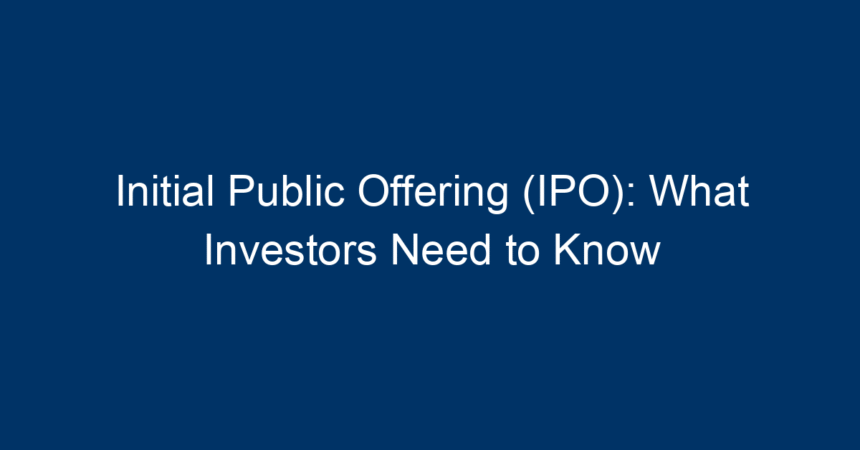Investing in the stock market can be a thrilling venture, offering the potential for lucrative returns. One of the most talked-about events in this sphere is the initial public offering (IPO). For both novice and seasoned investors, understanding an IPO can provide an invaluable edge in navigating the complex world of equity investments. This article will delve into the intricacies of IPOs, outlining what they are, how they work, their advantages and risks, and what investors need to consider before diving in.
What is an Initial Public Offering (IPO)?
An initial public offering (IPO) is the first time a company offers its shares to the public, transitioning from a privately held entity to a publicly traded one. This process allows companies to raise capital to fund growth, pay off debts, or invest in new projects. It also gives early investors and employees an opportunity to cash out on their investment or equity holdings.
The IPO Process: Step-by-Step
- Choosing Underwriters: Companies typically collaborate with investment banks that act as underwriters to help price and sell shares.
- Regulatory Filings: The company must file a registration statement with the Securities and Exchange Commission (SEC) in the U.S. This document includes detailed information about the company’s financials, risks, and business strategy.
- Roadshow: Before the IPO date, the company goes on a "roadshow," presenting to potential investors to generate interest and gauge demand.
- Pricing: After assessing investor interest, the underwriters will set the IPO price, which ultimately determines how much capital the company will raise.
- Launching the IPO: On the IPO date, shares are listed on an exchange, and public trading begins.
The Advantages of Investing in IPOs
Investing in an initial public offering (IPO) can offer several benefits:
Potential for High Returns
Investors often flock to IPOs in search of rapid growth. If a newly public company’s shares perform well, early investors can see substantial returns in a short period.
Access to Innovative Companies
IPOs provide opportunities to invest in cutting-edge companies that may have been previously inaccessible as private entities. This access can include firms in rapidly evolving sectors such as technology, biotech, and renewable energy.
Portfolio Diversification
Adding IPOs to your portfolio can enhance diversification, especially if you invest in companies operating in different markets or industries. Broadening your investment horizons can reduce overall portfolio risk.
Risks Involved with IPO Investments
While IPOs can be lucrative, they come with inherent risks:
High Volatility
The stock prices of newly public companies can exhibit extreme volatility, particularly during their first few days of trading. Investors may face significant price swings, making it difficult to predict short-term performance.
Lack of Historical Performance Data
As IPOs are new entities on the stock market, they lack the performance history that seasoned companies offer. This lack of data can make it tough for investors to assess future growth and stability.
Overvaluation Risk
If demand is high, IPOs can sometimes be priced above their fair market value, leading to a potential corrective downturn soon after the initial release.
Evaluating an IPO: Key Factors to Consider
Before diving into an initial public offering (IPO), it’s crucial to conduct thorough research. Here are some factors to keep in mind:
Financial Health
Examine the company’s financial statements, including revenue, profit margins, and debt levels. A growing and profitable company is generally a safer bet than one that is losing money or deeply in debt.
Business Model and Growth Potential
Analyzing the company’s business model is essential in understanding its potential for long-term growth. Look for unique selling propositions, competitive advantages, and market demand.
Management Team
A strong and experienced management team can significantly impact the company’s success. Research the backgrounds of key executives to understand their qualifications and track records.
Industry Trends
Evaluate the overall industry landscape. Is it in a growth phase or facing decline? Industry trends can influence a company’s future performance and market position.
How to Invest in an IPO
Investing in an initial public offering (IPO) involves specific steps:
Open a Brokerage Account
You’ll need a brokerage account that offers access to IPOs. Many brokers require you to meet criteria such as account minimums, experience levels, or prior investment history to access IPO shares.
Research the Upcoming IPOs
Stay updated on upcoming IPOs through financial news outlets or dedicated services. Research crucial details—like the date of the IPO and the expected price range.
Place Your Order
Depending on your brokerage, you may need to place your order in advance of the IPO. Make sure to specify the number of shares you wish to purchase and any limits on your price.
Monitor Your Investment
Once you’ve participated in an IPO, it’s vital to keep an eye on the stock’s performance, the company’s news, and market trends. Consider setting price alerts or regularly checking your portfolio.
Conclusion: Making Informed Decisions
Investing in an initial public offering (IPO) can be an exciting opportunity for growth and diversification. However, it also carries specific risks that necessitate careful consideration and research.
Actionable Insights for Investors
- Do Your Homework: Research potential investments thoroughly by reading the prospectus and analyzing financial statements.
- Assess Your Risk Tolerance: Understand how much risk you are willing to take. IPOs can be volatile, so analyze your financial situation before investing.
- Diversify Your Portfolio: Don’t put all your eggs in one basket. Consider balancing IPO investments with more established stocks or different asset classes.
- Stay Informed: Regularly follow market trends and news to make well-informed decisions about your investments.
By keeping these guidelines in mind, you will better navigate the exhilarating landscape of IPO investments, allowing you to capitalize on potential growth opportunities while minimizing risks. Always remember—knowledge is power in the world of investing!




